Charadriidae • Haematopodidae • Recurvirostridae • Scolopacidae • Laridae • Alcidae
This list contains pictures of birds found on the official Louisiana Checklist. These birds were photographed within the state except where noted. Birds marked with an asterisk (*) are currently on the review list of the Louisiana Bird Records Committee.
ORDER CHARADRIIFORMES
Family Charadriidae: Plovers
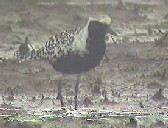
|
Black-Bellied Plover
Black-bellied Plover Also known as "Grey Plover". Black-bellieds have much larger bills, and black axillaries (in all plumages) which are easily seen on a bird in flight. They are also usually more plain-faced than American Golden Plover, with less conspicuous supercilia. |
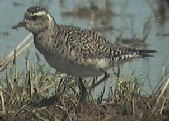
|
American Golden Plover
American Golden Plover is an abundant spring migrant, arriving as early as late February. At this time, most of these birds are barely beginning their molt into alternate plumage. By May, when the last of them are passing through the state, many are in full alternate plumage. Fall migrant Golden Plovers are rare, and should be checked carefully to eliminate the possibility of their being Pacific Golden Plovers. |
| |
Mongolian Plover* |
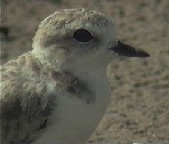
|
Snowy Plover
Snowy Plover is a rare nester (one record) and uncommon winterer in the state. It is found strictly coastally, and seems to prefer sandy beaches, while the similar Piping Plover seems equally comfortable on either sand or mud flats. Two major differences allow quick separation between Snowy and Piping: the legs of the Snowy are grayish, while those of Piping are orangish; and the bills of the two birds are of different shapes, long and slender in Snowy, shorter and stubbier, almost parrot-like in Piping. |

|
Wilson's Plover |
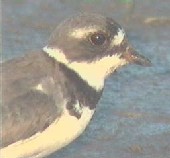
|
Semipalmated Plover |
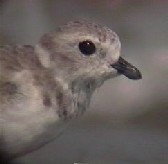
|
Piping Plover |
| |
Killdeer |
Family Haematopodidae: Oystercatchers
| |
American Oystercatcher |
Family Recurvirostridae: Stilts and Avocets
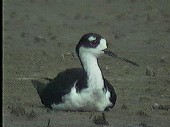
|
Black-Necked Stilt |
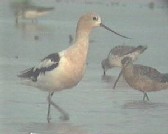
|
American Avocet |
Family Scolopacidae: Sandpipers, Phalaropes, and Allies
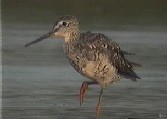
|
Greater Yellowlegs |
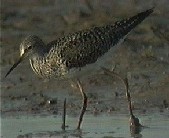
|
Lesser Yellowlegs |
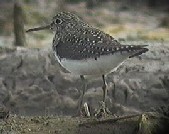
|
Solitary Sandpiper |
| |
Willet |
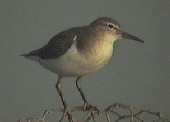
|
Spotted Sandpiper |
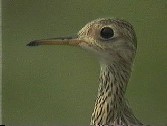
|
Upland Sandpiper |
| |
Eskimo Curler (Q)* |
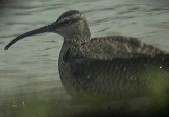
|
Whimbrel |
| |
Long-Billed Curlew |
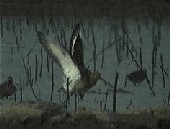
|
Black-Tailed Godwit* |
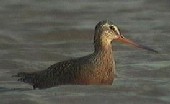
|
Hudsonian Godwit |
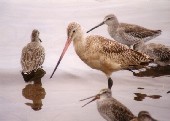
|
Marbled Godwit |
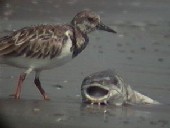
|
Ruddy Turnstone |
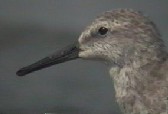
|
Red Knot |
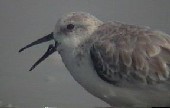
|
Sanderling |
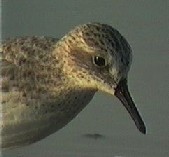
|
Semipalmated Sandpiper
Semipalms migrate through the state in huge numbers in spring, late summer and fall. Despite old references which state that this species is common in winter, it is actually unknown at that season. Similar Species: Western Sandpiper, Least Sandpiper, White-rumped Sandpiper, Baird's Sandpiper. |

|
Western Sandpiper
Western Sandpiper is the most common "peep" in Lousiana through most of the year. Aside from a period between mid-to-late April and early July, Westerns are abundant in South Louisiana. |
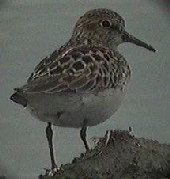
|
Least Sandpiper
Least Sandpiper is common in the state for most of the year, the exception being a short span of about a month from late May to early July. Although Leasts are usually lumped with Westerns and Semis in field guides, they actually seem like smaller versions of Pectorals, or White-rumpeds. With their thin, downcurved bills, brownish mantles and breasts, and picking style of feeding, these birds seem very similar in all but size. |
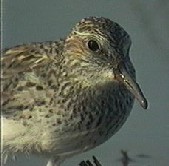
|
White-Rumped Sandpiper
The White-rumped Sandpiper is somewhat like a large Least or small Pectoral Sandpiper. It has a fairly long, curved bill, streaked breast, and often feeds by picking. It is, however, dark-legged, and of course has a white rump. The white rump also separates it from Baird's, which it resembles in terms of profile. The lower mandible of the White-rump is orangish, sometimes extensively. In alternate plumage, it has large dark feather centers on the scapulars, but much smaller dark areas on the wing coverts. The contrast between these feathers stands out, as does the pale fringing of the upperpart feathers, which give the bird a checkered look. Similar Species:Semipalmated Sandpiper, Western Sandpiper, Least Sandpiper, Baird's Sandpiper, Pectoral Sandpiper |
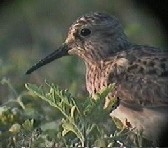
|
Baird's Sandpiper |
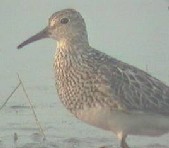
|
Pectoral Sandpiper |
| |
Purple Sandpiper* |
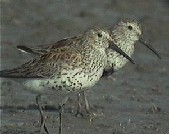
|
Dunlin |
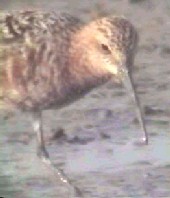
|
Curlew Sandpiper*
Curlew Sandpipers are rarities in Louisiana, although it's possible that a few sneak through every year among the millions of shorebirds that stop on migration in the ricefields of the state. The only documented sightings to date are in a narrow window from late April to early May. |
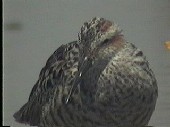
|
Stilt Sandpiper |
| |
Buff-Breasted Sandpiper |
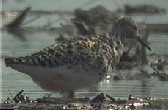
|
Ruff* |
| |
Short-Billed Dowitcher |
| |
Long-Billed Dowitcher |
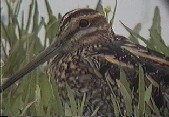
|
Common Snipe |
| |
American Woodcock |
| |
Wilson's Phalarope |
| |
Red-Necked Phalarope* |
Family Laridae: Skuas, Gulls, Terns, and Skimmers
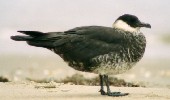
|
Pomarine Jaeger
The Pomarine Jaeger is the most common jaeger in Louisiana, and it is occasionally visible from shore. Scanning the large flocks of gulls that tag along behind shrimp trawlers is a good strategy for locating this bird, as jaegers tend to engage in conspicuous aerial chases hoping to force other birds to drop whatever food they've managed to scavenge. Jaegers can be a nightmare to identify, but if you happen to see an adult with its full set of tail feathers, or even better, find one on the beach that allows close approach (as this one did on a Texas beach), it should be much easier to put a name to the bird. |
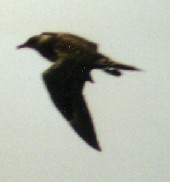
|
Parastic Jaeger*
The Parasitic Jaeger is rare in Louisiana, although with more winter trips into the Gulf it might prove to be more common than it is now considered. This picture, although blurry, shows the the elongated, spiky tail shape that of the species fairly well. |
| |
Long-Tailed Jaeger* |

|
Laughing Gull |

|
Franklin's Gull |
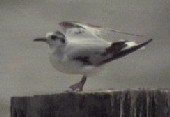
|
Little Gull* |
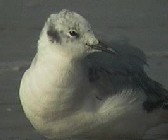
|
Bonaparte's Gull |
| |
Ring-Billed Gull |
| |
California Gull* |
| |
Herring Gull |
| |
Thayer's Gull* |
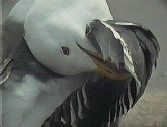
|
Lesser Black-Backed Gull
Although the first Louisiana sighting of this species was not made until 1981, reports of Lesser Black-backed Gulls have increased over the following years to the point where it will soon no longer be classed as a rarity. One or more can usually be found throughout much of the year on the beaches of Cameron Parish. Many field guides note a difficulty in separating 1st year birds of this species from 1st year Herring Gulls, but young Lesser Black-backeds are actually fairly easy to pick out in a flock of young Herrings. The feathers of the back on birds of this age are generally much darker in the centers than in same-aged Herrings, giving a distictinctly darker-backed look to the LBBG. The profile of the perched bird is also much more slender, as the folded wings extend further past the tail than in Herring. Lesser Black-backeds are generally smaller than Herrings. Older age classes have darker gray (not black) mantles than Herring, a shade of gray which is very similar to the mantle color of Laughing Gulls. Identification of this species has been made a little less straightforward by the appearance in Louisiana of birds believed to be Kelp Gulls, and by the assumed hybridisation of Kelp and Herring Gulls on the Chandeleur Islands. Kelp Gulls should have a much blacker back than LBBG. Kelp X Herring Gulls (as well as Great Black-backed X Herring), however, would probably be a close match for Lesser Black-backed. |
| |
Glaucous Gull* |
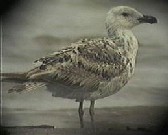
|
Great Black-Backed Gull*
This photo is of a bird filmed on April 14, 1996, on Rutherford Beach, Cameron Parish. As the inner primaries of the bird were in the process of molting, I assume that the bird is roughly a first-summer bird beginning its molt into second-winter plumage. |
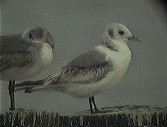
|
Black-Legged Kittiwake*
Black-legged Kittiwake is a rarity in Louisiana. It may be more common offshore than records indicate, as there have been few offshore trips during the winter, when it would probably be most common. Most state records of this species are of individuals that have been observed from the shore. To my knowledge, the majority of these records are of first-year birds. Young Black-legged Kittiwakes can be separated from similar species (Bonaparte's, Sabine's, and Little Gull) by the combination of yellowish bill, black legs, and black carpal bar and outer primaries forming a dark zigzag line across its upperwings. |
| |
Sabine's Gull |
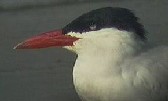
|
Caspian Tern |

|
Royal Tern |

|
Sandwich Tern |
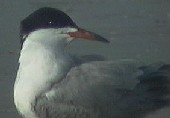
|
Common Tern |
| |
Arctic Tern* |
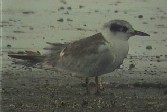
|
Forster's Tern |
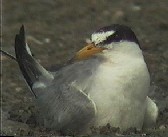
|
Least Tern |
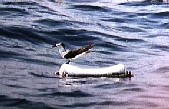
|
Bridled Tern |
| |
Sooty Tern |
| |
Black Tern |
| |
Brown Noddy* |
Family Alcidae: Auks, Murres, and Puffins